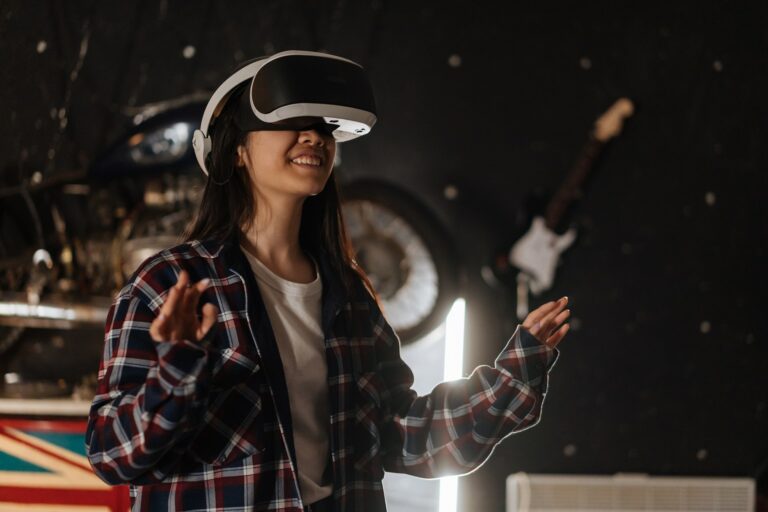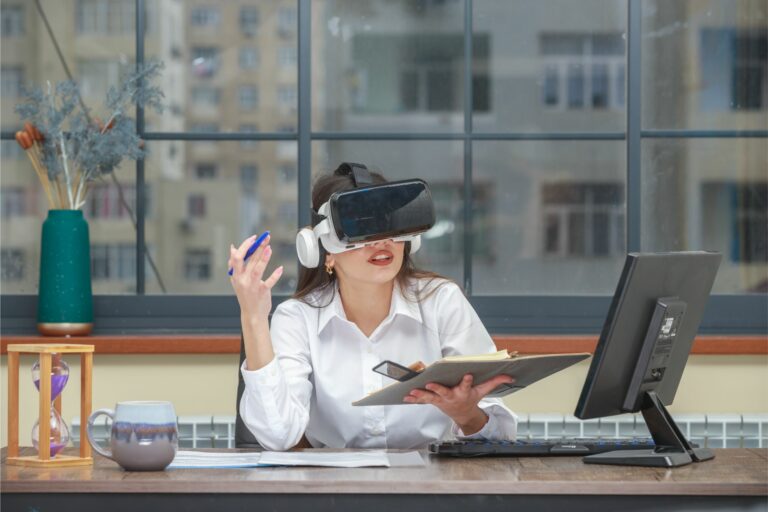Unlocking Opportunities: Exploring the Growing XR Job Market and How to Land Your Dream Role
Are you ready to step into the exciting world of XR (Extended Reality) and unlock a wealth of opportunities in the job market? As technology continues to evolve, so does our immersive digital experience, presenting a multitude of possibilities for both businesses and individuals alike. In this rapidly growing field, XR is revolutionizing industries such as gaming, entertainment, education, healthcare, and more. Whether you’re a tech enthusiast or a creative visionary, there has never been a better time to explore the diverse roles available in the XR job market. From virtual reality developers to augmented reality designers, the demand for skilled professionals is skyrocketing. So, how can you land your dream role in this exciting industry? Join us as we delve into the world of XR, uncovering the skills, qualifications, and insider tips that will set you apart and help you secure your place in this exhilarating field. Get ready to unlock endless possibilities and embark on a thrilling career journey in XR.
The growing demand for XR professionals
The XR job market is experiencing unprecedented growth, with companies across various industries recognizing the immense potential of this technology. As businesses seek to enhance user experiences, increase productivity, and gain a competitive edge, the demand for skilled XR professionals has soared. According to recent reports, the XR industry is projected to reach a market size of $209.2 billion by 2022, indicating a tremendous opportunity for aspiring XR enthusiasts. The combination of virtual reality (VR), augmented reality (AR), and mixed reality (MR) has opened up avenues for innovation in gaming, training, marketing, and beyond. Whether you’re interested in developing immersive applications, designing interactive experiences, or creating virtual worlds, the XR job market offers a plethora of exciting roles to explore.
The demand for XR professionals is not limited to a single sector. Industries such as gaming, entertainment, healthcare, real estate, engineering, education, and retail are actively incorporating XR technologies into their operations. Gaming companies are leveraging VR and AR to provide gamers with unparalleled experiences, while the entertainment industry is using XR to enhance live performances, movies, and theme parks. In healthcare, XR is revolutionizing patient care by enabling virtual surgeries, pain management, and mental health therapies. Real estate developers are utilizing XR to offer virtual property tours, and engineers are using it for immersive design and prototyping. XR is also transforming education, making learning more engaging and interactive. Retailers are adopting XR to provide customers with virtual try-on experiences and personalized shopping. The opportunities in XR span across multiple sectors, making it a versatile and in-demand field.
The rapid growth of XR has also been fueled by advancements in hardware and software technologies. From high-quality headsets to powerful graphical processing units, the tools and equipment required for XR development have become more accessible and affordable. Additionally, the increasing availability of software development kits (SDKs) and platforms has made it easier for aspiring XR professionals to enter the industry. With the combination of growing demand, expanding industries, and evolving technologies, the XR job market is ripe with opportunities for those willing to embrace this transformative field.
Key industries and sectors embracing XR
Gaming
The gaming industry has been at the forefront of XR adoption, utilizing VR and AR to create immersive and interactive gaming experiences. From virtual reality headsets to augmented reality games on smartphones, XR has revolutionized the way we play and engage with games.
Entertainment
XR technologies are being incorporated into the entertainment industry to enhance live performances, movies, and theme parks. From virtual reality concerts to augmented reality movie experiences, XR is bringing a new level of engagement and immersion to entertainment.
Healthcare
XR is transforming the healthcare industry by enabling virtual surgeries, pain management, mental health therapies, and medical training simulations. It has the potential to revolutionize patient care, improve treatment outcomes, and enhance medical education.
Real Estate
XR is being used in the real estate industry to offer virtual property tours, allowing potential buyers to explore properties remotely. It provides a realistic and immersive experience, saving time and resources for both buyers and sellers.
Engineering
XR is revolutionizing engineering by enabling immersive design and prototyping. Engineers can visualize and interact with virtual models, making it easier to detect design flaws and improve the overall design process.
Education
XR is transforming education by making learning more engaging and interactive. Students can explore virtual environments, conduct virtual experiments, and interact with virtual objects, enhancing their understanding and retention of complex concepts.
Retail
XR technologies are being adopted by retailers to provide customers with virtual try-on experiences and personalized shopping. Virtual reality mirrors and augmented reality apps allow customers to visualize products in real time, enhancing the shopping experience.
These key industries and sectors are just a few examples of how XR is being embraced and integrated into various fields. As the technology continues to evolve, the opportunities for XR professionals will only continue to grow.
XR job market statistics and trends
The XR job market is experiencing exponential growth, with an increasing number of companies recognizing the value of XR technologies. According to a report by MarketsandMarkets, the XR market is projected to grow at a compound annual growth rate (CAGR) of 45.7% from 2019 to 2024. This growth is primarily driven by the demand for immersive experiences and the need for businesses to stay competitive in a rapidly evolving digital landscape.
In terms of job roles, the XR industry offers a wide range of opportunities. Some of the most in-demand roles include XR developers, XR designers, XR artists, XR engineers, XR content creators, and XR project managers. These roles require a combination of technical skills, creative abilities, and an understanding of user experience (UX) design principles.
In addition to technical skills, soft skills such as problem-solving, communication, and teamwork are highly valued in the XR industry. As XR projects often involve cross-functional teams and collaboration with stakeholders, the ability to effectively communicate and work well with others is crucial.
One of the emerging trends in the XR job market is the demand for specialized skills and expertise in specific industries. For example, healthcare companies are seeking XR professionals with a background in medical imaging and patient care, while gaming companies are looking for XR developers with experience in game design and programming. As XR continues to expand into different sectors, professionals with domain-specific knowledge will be highly sought after.
Another trend in the XR job market is the rise of freelancing and remote work opportunities. With advancements in connectivity and collaboration tools, XR professionals can work remotely and collaborate with teams from around the world. This flexibility allows individuals to take on projects from various industries and work on cutting-edge XR technologies without being limited to a specific geographic location.
Overall, the XR job market is experiencing rapid growth and offers a range of exciting opportunities for professionals with the right skills and qualifications. By staying up-to-date with the latest trends and honing the necessary skills, individuals can position themselves for success in this dynamic field.
Skills and qualifications required for XR roles
To thrive in the XR job market, it is essential to possess a combination of technical skills, creative abilities, and domain knowledge. Here are some of the key skills and qualifications required for XR roles:
Programming and development skills
Proficiency in programming languages such as C++, C#, JavaScript, and Unity is crucial for XR developers. Understanding the principles of object-oriented programming and having experience with XR development frameworks and tools are also highly valued.
Design and artistic skills
XR designers and artists should have a strong sense of aesthetics and an eye for detail. Proficiency in graphic design, 3D modeling, animation, and user interface (UI) and user experience (UX) design is essential for creating immersive and visually appealing XR experiences.
Domain-specific knowledge
Depending on the industry you plan to work in, having domain-specific knowledge can give you a competitive edge. For example, if you’re interested in healthcare XR, understanding medical imaging, anatomy, and patient care can be advantageous.
Problem-solving and critical thinking
XR professionals often encounter complex challenges that require creative problem-solving and critical thinking skills. The ability to analyze problems, think outside the box, and find innovative solutions is highly valued in the XR industry.
Collaboration and teamwork
XR projects often involve cross-functional teams and collaboration with stakeholders from different departments. The ability to collaborate effectively, communicate ideas, and work well with others is crucial for success in the XR job market.
Continuous learning and adaptability
The XR industry is constantly evolving, and new technologies and tools are being introduced regularly. Being open to learning new skills, staying up-to-date with industry trends, and adapting to changes are essential for long-term success in the XR job market.
In addition to these skills, having a strong educational background or relevant certifications can enhance your credibility and increase your chances of securing XR roles. Pursuing a degree in computer science, game development, graphic design, or a related field can provide a solid foundation for a career in XR.
Building a strong XR portfolio and resume
When applying for XR roles, having a strong portfolio and an impressive resume is essential to showcase your skills and stand out from the competition. Here are some tips for building a strong XR portfolio and resume:
Showcase your best work
Select your most impressive XR projects and include them in your portfolio. Demonstrate your ability to create immersive experiences, attention to detail, and technical expertise. Include screenshots, videos, or links to interactive demos to give potential employers a glimpse of your work.
Highlight your technical skills
In your resume, clearly outline your technical skills and expertise in XR development frameworks, programming languages, software tools, and hardware platforms. Be specific about your experience with VR, AR, and MR technologies.
Include relevant experience
If you have previous experience working on XR projects or in related industries, highlight this in your resume. Include details about the projects you worked on, your role and responsibilities, and the outcomes or impact of your work.
Describe your creative process
In your portfolio and resume, explain your creative process and how you approach XR design and development. Discuss your problem-solving strategies, your understanding of user experience principles, and your ability to create immersive and engaging experiences.
Provide references and testimonials
If you have worked with clients, collaborators, or supervisors who can vouch for your skills and work ethic, include their contact information or request testimonials. Positive references can significantly enhance your credibility and demonstrate your professionalism.
Continuously update your portfolio and resume
As you gain more experience and complete new projects, regularly update your portfolio and resume to showcase your latest work. Remove outdated or less relevant projects to keep your portfolio focused and impressive.
Remember, your portfolio and resume should reflect your unique skills, creativity, and passion for XR. Tailor your portfolio to the specific role or industry you are targeting and ensure that it accurately represents your abilities.
Networking and connecting with XR professionals
Networking plays a crucial role in landing your dream role in the XR industry. Building connections with XR professionals can open doors to new opportunities, provide valuable insights, and expand your knowledge. Here are some ways to network and connect with XR professionals:
Attend industry events and conferences
XR conferences, trade shows, and industry events offer excellent opportunities to meet professionals in the field. Participate in panel discussions, attend workshops, and engage in conversations with fellow attendees. Be proactive in exchanging contact information and following up with potential connections.
Join XR communities and online forums
Online communities and forums dedicated to XR are a great way to connect with like-minded professionals. Participate in discussions, ask questions, and share your knowledge and expertise. Platforms such as Reddit, LinkedIn groups, and specialized XR forums can provide valuable networking opportunities.
Collaborate on XR projects
Seek out opportunities to collaborate with other XR professionals on projects. Participate in hackathons, game jams, or join XR development teams. Collaborative projects not only allow you to showcase your skills but also provide a chance to learn from others and establish valuable connections.
Use social media
Utilize social media platforms such as LinkedIn, Twitter, and Instagram to connect with XR professionals and industry influencers. Follow relevant hashtags, engage in conversations, and share your work to gain visibility within the XR community. Building a strong online presence can attract opportunities and connections.
Reach out to mentors and industry experts
Identify professionals in the XR industry whom you admire and reach out to them for mentorship or guidance. Many experienced XR professionals are willing to share their insights and offer advice to aspiring individuals. Attend webinars or workshops hosted by industry experts and take advantage of the opportunity to connect with them.
Remember, networking is a two-way street. Be genuine in your interactions, offer help and support to others, and maintain professional relationships. Building a strong network of XR professionals can not only help you find job opportunities but also provide ongoing support and learning opportunities throughout your career.
Job search strategies for the XR industry
When searching for XR job opportunities, it’s essential to have a well-defined strategy that maximizes your chances of success. Here are some job search strategies specifically tailored for the XR industry:
Research XR-focused companies
Identify companies that are actively working on XR projects or have a strong focus on XR technologies. Research their products, services, and recent projects to gain insights into their XR initiatives. Visit their career pages or reach out directly to inquire about job openings.
Leverage specialized job boards and platforms
Utilize job boards and platforms that focus specifically on XR roles. Websites such as XRDC, VRJobs, and AR Insider offer dedicated job listings for XR professionals. Sign up for email alerts and regularly check these platforms for new job opportunities.
Network and leverage connections
As mentioned earlier, networking is crucial in the XR industry. Leverage your connections, attend industry events, and engage with XR professionals to learn about hidden job opportunities. Many XR roles are filled through referrals and personal connections.
Showcase your skills on XR platforms
XR-specific platforms such as Unity Connect, Sketchfab, and ArtStation provide opportunities to showcase your XR work and attract potential employers. Create a compelling profile, upload your projects, and engage with the XR community on these platforms.
Create a strong online presence
Establish a strong online presence by maintaining an up-to-date LinkedIn profile, sharing your work on social media, and contributing to XR-related discussions and forums. Engage with XR professionals, industry influencers, and companies to increase your visibility.
Freelancing and project-based work
Consider freelancing or taking on project-based work to gain experience and build your portfolio. Platforms such as Upwork, Freelancer, and Toptal offer opportunities to find XR-related projects and clients.
Immersive Escapes: Unraveling the Future of VR Entertainment
Virtual Reality (VR) has emerged as a groundbreaking technology, revolutionizing the way we experience entertainment. By transporting us to captivating digital realms, VR offers immersive escapes that push the boundaries of our imagination. In this article, we will delve into the future of VR entertainment, exploring its potential impact on various industries and the ways it enhances our lives.
Table of Contents
- Introduction
- Evolution of VR Entertainment
- VR Gaming: Unlocking New Realms of Adventure
- Virtual Travel: Wander the World from Home
- VR Cinema: Redefining Movie-watching Experience
- Education and Training in Virtual Reality
- The Future of VR Entertainment
- Overcoming Challenges in VR
- Conclusion
- FAQs
1. Introduction
In recent years, VR technology has advanced by leaps and bounds, allowing us to step into immersive virtual environments like never before. With its ability to simulate realistic experiences, VR has the potential to transform the entertainment landscape. Let’s explore the exciting possibilities that lie ahead.
2. Evolution of VR Entertainment
The concept of VR dates back to the 1960s, but it is only in recent times that technology has become accessible to the masses. Early iterations of VR devices were bulky and expensive, limiting their popularity. However, with advancements in hardware and software, VR has become more affordable, comfortable, and visually stunning, paving the way for its widespread adoption.
3. VR Gaming: Unlocking New Realms of Adventure
Gaming is one of the primary domains where VR has gained significant traction. By donning a VR headset and using motion controllers, players can enter virtual worlds and engage in fully immersive gameplay. VR gaming offers a heightened sense of presence and interactivity, allowing users to experience breathtaking adventures, solve puzzles, and compete with others in multiplayer environments.
4. Virtual Travel: Wander the World from Home
VR has the power to transport us to far-flung destinations without leaving our homes. Through virtual travel experiences, users can explore iconic landmarks, stroll along sandy beaches, and visit historical sites. This technology opens up new possibilities for individuals who are physically unable to travel or wish to preview destinations before planning their trips.
5. VR Cinema: Redefining Movie-watching Experience
Imagine sitting in a virtual movie theater, surrounded by a breathtaking digital environment, and watching a film in larger-than-life proportions. VR cinema takes movie-watching to a whole new level by providing an immersive setting where viewers can feel like part of the story. It offers a unique blend of storytelling and visual spectacle that enhances the overall cinematic experience.
6. Education and Training in Virtual Reality
VR is revolutionizing the field of education and training by creating simulated environments that facilitate immersive learning. From medical students practicing surgeries to pilots honing their flying skills, VR provides a safe and controlled space for hands-on training. It enables learners to gain practical experience, explore complex scenarios, and accelerate their learning curve.
7. The Future of VR Entertainment
As technology continues to advance, the future of VR entertainment holds immense potential. We can anticipate more lifelike graphics, enhanced haptic feedback, and improved motion tracking systems, which will further blur the line between reality and virtuality. Moreover, advancements in artificial intelligence and machine learning will contribute to creating more realistic virtual worlds and intelligent virtual characters.
8. Overcoming Challenges in VR
While VR presents a myriad of opportunities, it also faces certain challenges. The technology needs to become more accessible and affordable for widespread adoption. Additionally, addressing concerns related to motion sickness and designing user-friendly interfaces will contribute to a more seamless and comfortable VR experience. With ongoing research and innovation, these challenges can be overcome.
9. Conclusion
VR entertainment has already made a significant impact, and its future promises even more captivating experiences. From gaming and virtual travel to cinema and education, VR is reshaping how we engage with entertainment content. As technology continues to evolve, we can look forward to a world where virtual experiences seamlessly blend with our physical reality.
10. FAQs
Q1. Is VR entertainment only limited to gaming?
No, VR entertainment encompasses various sectors, including gaming, virtual travel, cinema, education, and more. The technology is versatile and offers immersive experiences across different domains.
Q2. Can I experience VR entertainment without owning expensive equipment?
Yes, there are VR arcades and gaming centers that provide access to VR experiences without the need for personal equipment. This allows users to try VR without a substantial upfront investment.
Q3. Is VR safe for children?
While VR experiences can be enjoyable for children, it is important to consider age-appropriate content and limit their exposure to prolonged VR sessions. Parents should supervise their children’s VR activities and ensure they take regular breaks.
Q4. Will VR replace traditional forms of entertainment?
VR is unlikely to replace traditional forms of entertainment entirely. Instead, it will complement existing mediums by offering unique and immersive experiences that cannot be replicated elsewhere.
Q5. How long does it take to adapt to VR?
Adapting to VR varies from person to person. Some individuals may require minimal adjustment, while others might take a little longer to get acclimated. It is important to start with shorter sessions and gradually increase the duration to avoid discomfort.
In conclusion, VR entertainment is poised to reshape the way we engage with digital content. Whether it’s gaming, travel, cinema, or education, VR offers us a gateway to immersive escapes that captivate our senses. As technology advances and barriers are overcome, the future of VR entertainment looks incredibly promising, opening up endless possibilities for unparalleled experiences. So, fasten your VR headset and get ready to embark on thrilling adventures in the virtual realm.
Beyond Imagination: Unveiling the Promising Future of Virtual Reality
Table of Contents
1. Introduction
2. The Evolution of Virtual Reality
3. Virtual Reality Applications
4. Advancements in Virtual Reality Technology
5. The Impact of Virtual Reality
6. Challenges and Opportunities
7. Future Innovations and Possibilities
8. Conclusion
1. Introduction
Virtual reality (VR) has come a long way since its inception. It has transformed from a futuristic concept to a promising technology that is revolutionizing various industries. With its immersive and interactive nature, virtual reality is poised to reshape the way we perceive and experience the world around us. In this article, we will explore the evolution of virtual reality, its applications, technological advancements, impact on society, challenges, and the exciting future that awaits.
2. The Evolution of Virtual Reality
Virtual reality traces its roots back to the mid-20th century when pioneers like Morton Heilig and Ivan Sutherland laid the foundations for immersive experiences. However, it wasn’t until the late 20th and early 21st centuries that virtual reality gained significant traction. The advancements in computing power, graphics, and display technologies propelled VR into the mainstream.
3. Virtual Reality Applications
Gaming and Entertainment
One of the primary domains where virtual reality has made a tremendous impact is gaming and entertainment. VR gaming offers an unparalleled level of immersion, allowing players to step into virtual worlds and engage with their surroundings in unprecedented ways.
Education and Training
Virtual reality has also found its way into the realm of education and training. By creating realistic simulations and interactive environments, VR enables learners to gain practical skills and experiences in a safe and controlled setting. From medical training to flight simulations, the potential applications are vast.
Healthcare and Therapy
Virtual reality has shown immense potential in the healthcare industry. It can be utilized for pain management, exposure therapy, rehabilitation, and mental health treatments. VR provides a controlled and customizable environment for patients, enhancing their well-being and aiding in their recovery.
Architecture and Design
Architects and designers can harness the power of virtual reality to visualize and present their concepts more effectively. VR enables clients to experience virtual walkthroughs of buildings, interiors, and landscapes, allowing for better decision-making and collaboration.
4. Advancements in Virtual Reality Technology
Virtual reality technology continues to evolve at a rapid pace, bringing us closer to more immersive and realistic experiences.
Improved Headsets and Displays
Modern VR headsets offer higher resolutions, wider fields of view, and reduced latency, resulting in more convincing and comfortable experiences for users.
Enhanced Sensory Feedback
Developments in haptic feedback systems enable users to feel and interact with virtual objects more realistically. Through tactile sensations and force feedback, VR can simulate textures, vibrations, and even resistance.
Realistic Environments
Advancements in graphics processing have allowed for more realistic and visually stunning virtual environments. From detailed textures to lifelike lighting, VR environments can now rival the quality of the physical world.
Gesture and Motion Tracking
Incorporating sensors and cameras, VR systems can track users’ movements and gestures accurately. This enables natural interaction within virtual environments, further enhancing the sense of presence.
5. The Impact of Virtual Reality
Transforming Industries
Virtual reality has the potential to transform various industries. From architecture and tourism to healthcare and manufacturing, VR is revolutionizing how businesses operate, train employees, and engage with customers.
Revolutionizing Communication
VR has the power to revolutionize communication by enabling virtual meetings, remote collaborations, and immersive storytelling. It brings people together across distances, fostering a sense of presence and shared experiences.
Empowering Virtual Experiences
Virtual reality opens up a world of possibilities for experiencing events, locations, and activities that might otherwise be inaccessible. From virtual travel to attending live concerts, VR allows individuals to transcend physical limitations and immerse themselves in new and exciting realms.
6. Challenges and Opportunities
While virtual reality holds immense promise, it also faces several challenges and presents opportunities for growth.
Overcoming Motion Sickness
Motion sickness is a common issue experienced by some users in virtual reality. Researchers and developers are continually working on minimizing this discomfort by improving tracking accuracy and reducing latency.
Ethical Considerations
As virtual reality becomes more pervasive, ethical considerations arise. Privacy concerns, content regulation, and the psychological impact of immersive experiences are important areas that need attention.
Accessibility and Affordability
For virtual reality to reach its full potential, accessibility and affordability are crucial factors. Continued advancements in hardware, software, and pricing models will make VR more accessible to a wider audience.
Business and Market Potential
The business and market potential of virtual reality is immense. Industries such as gaming, healthcare, and education are already leveraging VR, and the market is expected to grow exponentially in the coming years.
7. Future Innovations and Possibilities
The future of virtual reality holds exciting innovations and possibilities.
Augmented Reality Integration
The integration of virtual reality with augmented reality (AR) can create powerful mixed reality experiences. This combination enables users to interact with virtual elements superimposed on the physical world, opening up new dimensions of interaction and exploration.
Virtual Reality in Everyday Life
As VR technology becomes more compact and user-friendly, it has the potential to become an integral part of everyday life. From virtual social interactions to immersive media consumption, VR could enhance our daily experiences in unprecedented ways.
Virtual Travel and Exploration
Imagine being able to explore ancient ruins, walk on distant planets, or dive into the depths of the ocean, all from the comfort of your home. Virtual reality has the potential to revolutionize travel and exploration by offering realistic and immersive virtual experiences.
Collaborative Virtual Environments
Virtual reality has the potential to create collaborative environments where individuals from different locations can work, learn, and socialize together. Virtual meetings, conferences, and classrooms can foster engagement and collaboration on a global scale.
8. Conclusion
Virtual reality has surpassed the realm of science fiction and is now poised to shape our future. Its applications span across various domains, from gaming and education to healthcare and communication. With ongoing technological advancements and a growing market, the possibilities for virtual reality are beyond imagination. Embracing this transformative technology will unlock new opportunities and open doors to a promising future.
Step into Tomorrow: Discovering the Spectacular Advancements in VR
Introduction
Welcome to a world where the boundaries of reality are pushed to new horizons. Virtual reality (VR) has become a game-changing technology, transforming our understanding and engagement with digital content. In this article, we will delve into the spectacular advancements in VR, exploring its immersive experiences, practical applications, and future potential. Get ready to step into tomorrow and uncover the wonders of virtual reality.
The Evolution of Virtual Reality
Over the years, VR technology has witnessed a remarkable evolution. From its humble beginnings as a niche concept, it has now become more accessible and widely adopted. Let’s take a closer look at the key milestones that have shaped the advancement of VR.
1. The Birth of Virtual Reality
The term “virtual reality” was coined by Jaron Lanier, a computer scientist, in the late 1980s. However, the idea of immersing oneself in a virtual world dates back even further. In the 1960s, Ivan Sutherland introduced the concept of “The Ultimate Display,” envisioning a computer-generated environment that could be experienced through a head-mounted display.
2. Early Attempts and Commercialization
In the 1990s, companies like Sega and Nintendo released VR gaming consoles, bringing virtual reality into the mainstream. However, the technology at that time was limited by low-resolution displays and cumbersome equipment, hindering its widespread adoption.
3. Modern Era Advancements
In recent years, significant advancements in VR technology have propelled it into new heights of realism and immersion. The development of high-resolution displays, powerful graphics processing units (GPUs), and sophisticated tracking systems have greatly enhanced the VR experience.
The Power of Immersive Experiences
VR offers an unparalleled level of immersion, transporting users to virtual realms that captivate their senses. Whether it’s exploring ancient civilizations, embarking on thrilling adventures, or collaborating with others in virtual environments, the possibilities are endless.
Virtual Reality Gaming: Where Fantasy Meets Reality
VR gaming has emerged as one of the most popular applications of this technology. With the ability to step into the shoes of your favorite characters, VR gaming delivers an unprecedented level of immersion. From heart-pounding action games to thought-provoking puzzles, VR gaming takes entertainment to a whole new level.
Educational Virtual Reality: Learning Beyond Boundaries
Education is another field where VR has made significant strides. By creating immersive and interactive learning environments, students can explore historical events, understand complex scientific concepts, and even visit places they could only dream of. VR-based education offers a dynamic and engaging learning experience that enhances retention and understanding.
Virtual Tourism: Travel Without Limits
Have you ever wished to visit the Pyramids of Giza or explore the Great Barrier Reef? With VR, you can travel to any corner of the world without leaving your living room. Virtual tourism allows users to experience famous landmarks, cultural heritage sites, and natural wonders, providing a glimpse into different cultures and destinations.
The Advancements That Shape the Future
As technology continues to advance, the future of VR holds tremendous potential for even more astonishing experiences. Let’s explore some of the cutting-edge advancements that are shaping the future of virtual reality.
1. Next-Generation Displays
One of the key areas of development in VR is the improvement of displays. Higher resolution screens with increased pixel density and wider field of view are on the horizon. These advancements will eliminate the screen-door effect and deliver a more realistic and immersive visual experience.
2. Enhanced Haptic Feedback
Haptic feedback, the sense of touch, plays a crucial role in creating a realistic virtual experience. Advancements in haptic technology aim to provide more precise and detailed tactile sensations, allowing users to feel the texture of virtual objects and even experience physical impacts within the virtual environment.
3. Artificial Intelligence Integration
Artificial intelligence (AI) is set to revolutionize VR by enhancing its capabilities in various aspects. AI algorithms can analyze user behavior and preferences, adapt virtual environments in real-time, and create dynamic and personalized experiences. This integration will lead to more intelligent and interactive VR applications.
Frequently Asked Questions (FAQs)
Q: What is virtual reality (VR)?
A: Virtual reality is a technology that creates a computer-generated environment that simulates a realistic experience. By using headsets or goggles, users can immerse themselves in a virtual world and interact with it through specialized controllers or sensors.
Virtual reality offers a wide range of applications, including gaming, education, training, healthcare, and virtual tourism. It has the potential to revolutionize various industries and enhance the way we experience digital content.
Q: What are the advantages of virtual reality?
A: Virtual reality provides numerous benefits, such as:
- Immersive experiences that transport users to virtual realms.
- Enhanced learning opportunities through interactive and engaging educational content.
- Improved training simulations for professionals in various fields.
- Virtual travel and exploration of distant places without leaving home.
- Opportunities for social interactions and collaboration in virtual environments.
Q: Are there any health concerns related to virtual reality?
A: While VR technology is generally safe, some users may experience discomfort or motion sickness, especially if they are prone to these conditions. It is recommended to take breaks and adjust VR settings to individual comfort levels. Additionally, prolonged use of VR headsets may cause eye strain, so it is advisable to follow usage guidelines provided by manufacturers.
Q: Can virtual reality be used for therapy or rehabilitation?
A: Yes, virtual reality has shown promising results in therapeutic and rehabilitation settings. It can be used to treat phobias, PTSD, anxiety disorders, and even provide pain management. VR-based therapies create controlled and immersive environments to help individuals overcome their challenges in a safe and supportive manner.
Q: What does the future hold for virtual reality?
A: The future of VR is incredibly exciting. As technology advances, we can expect more realistic visuals, enhanced haptic feedback, improved AI integration, and expanded applications in various industries. Virtual reality has the potential to reshape how we interact with digital content and create immersive experiences beyond our imagination.
Conclusion
Virtual reality continues to astound us with its remarkable advancements. From immersive gaming experiences to transformative applications in education, healthcare, and beyond, VR has the power to transport us into virtual realms like never before. As technology evolves, the future holds even more incredible possibilities for this groundbreaking technology. So, step into tomorrow and embrace the spectacular advancements in VR, as we embark on a journey where the line between the real and virtual world becomes beautifully blurred.
The Next Level of Reality: Exploring the Future of VR Technology
Introduction
Welcome to a world where reality and imagination merge, where you can step into alternate dimensions and embark on extraordinary adventures without leaving your living room. Virtual Reality (VR) technology has taken giant leaps forward, transporting us to the next level of reality. In this article, we will delve into the captivating world of VR and explore its future possibilities. Prepare to be amazed as we uncover the boundless potential of The Next Level of Reality: Exploring the Future of VR Technology.
The Fascinating Origins of VR
Before we dive into the future, let’s take a moment to appreciate the roots of VR technology. The concept of immersing oneself in a virtual environment has been a long-standing dream for humans. The idea can be traced back to the 1960s, when Ivan Sutherland, a pioneer in computer graphics, introduced the concept of a head-mounted display (HMD) and created the first VR headset. Since then, numerous advancements have paved the way for the VR experiences we enjoy today.
The Current State of VR Technology
VR has come a long way since its humble beginnings. Modern VR headsets, such as the Oculus Rift, HTC Vive, and PlayStation VR, offer an unprecedented level of immersion and interactivity. These headsets, coupled with powerful gaming PCs or consoles, allow users to step into virtual worlds that are indistinguishable from reality. From exploring ancient ruins to battling virtual foes, the possibilities are virtually endless.
The Next Level of Reality: Exploring the Future of VR Technology
1. Artificial Intelligence in VR
One of the most exciting prospects for the future of VR is the integration of artificial intelligence (AI). AI algorithms have the potential to enhance the realism and interactivity of virtual environments. Imagine having intelligent NPCs (non-player characters) that can engage in meaningful conversations, adapt to your actions, and provide realistic responses. AI-driven VR experiences will blur the line between virtual and real, creating immersive worlds that feel truly alive.
2. Haptic Feedback and Sensory Integration
To take VR to the next level, developers are focusing on incorporating haptic feedback and sensory integration into VR systems. Haptic feedback technology allows users to feel realistic sensations through vibrations or touch feedback. Combined with sensory integration, which engages multiple senses simultaneously, VR experiences can become incredibly immersive. From feeling the gentle breeze on your face to experiencing the rumble of an earthquake, the future of VR will be a multisensory extravaganza.
3. Augmented Reality and Mixed Reality
While VR primarily immerses users in virtual worlds, the future holds great potential for the convergence of VR with augmented reality (AR) and mixed reality (MR). AR overlays virtual elements onto the real world, enhancing our perception of reality. MR, on the other hand, seamlessly blends virtual and real elements, allowing users to interact with both. Imagine a future where you can transform your living room into a virtual battlefield or have virtual companions walking beside you on your morning jog. The possibilities are mind-boggling.
4. Medical Applications of VR
VR is not limited to the realm of gaming and entertainment. It is increasingly being used in various fields, including medicine. Surgeons can now practice complex procedures in a risk-free virtual environment, enhancing their skills and minimizing the chances of errors during real surgeries. Virtual reality (VR) is employed for pain management, rehabilitation, and the treatment of mental health conditions as well. The future will witness further advancements in medical applications, revolutionizing healthcare as we know it.
5. Virtual Tourism and Remote Collaboration
With VR technology, you can travel to exotic destinations without leaving your home. Virtual tourism allows users to explore famous landmarks, visit museums, and even dive into the depths of the ocean, all from the comfort of their VR headset. Additionally, VR enables remote collaboration, bridging the gap between colleagues and friends separated by physical distance. Virtual meetings, conferences, and social gatherings will become more immersive and engaging, transforming the way we interact.
6. Ethical Considerations and Social Impact
As VR technology continues to evolve, it is essential to address the ethical considerations and potential social impact. VR can create powerful experiences that blur the boundaries between real and virtual, raising questions about the consequences of prolonged exposure to simulated environments. Additionally, issues such as data privacy, content regulation, and addiction need to be carefully examined. The future of VR lies not only in technological advancements but also in responsible and mindful usage.
Frequently Asked Questions (FAQs)
FAQ 1: Is VR only for gaming?
No, VR is not limited to gaming. While gaming is one of the most popular applications of VR, the technology has diverse applications in fields such as education, training, healthcare, and entertainment.
FAQ 2: Can VR cause motion sickness?
Some individuals may experience motion sickness or discomfort while using VR due to the sensory disconnect between visual input and physical movement. However, advancements in VR technology are addressing this issue, and many users can now enjoy VR without experiencing motion sickness.
FAQ 3: Are VR headsets suitable for children?
VR headsets are generally not recommended for children under the age of 13 due to potential adverse effects on their visual development. It is crucial to follow the age guidelines provided by manufacturers and ensure appropriate supervision when children use VR.
FAQ 4: Will VR replace traditional forms of entertainment?
VR is not poised to replace traditional forms of entertainment but rather complement them. It offers unique and immersive experiences that traditional media cannot replicate. However, traditional forms of entertainment will continue to coexist with VR.
FAQ 5: What are the hardware requirements for VR?
The hardware requirements for VR vary depending on the specific VR system. High-end VR experiences often require powerful gaming PCs or consoles, while standalone VR headsets have built-in hardware. It is important to check the recommended specifications before purchasing a VR system.
FAQ 6: How much does VR technology cost?
The cost of VR technology varies depending on the complexity and quality of the system. Entry-level VR headsets can be affordable, starting from a few hundred dollars, while high-end setups can cost several thousand dollars. It is important to research and choose a system that fits your budget and requirements.
Conclusion
The future of VR technology holds immense promise and potential. From AI integration and haptic feedback to the convergence of VR with AR and MR, the next level of reality is set to revolutionize various industries and reshape our daily lives. However, as we venture into this exciting frontier, it is crucial to address ethical considerations and ensure responsible usage. The Next Level of Reality: Exploring the Future of VR Technology is an exhilarating journey into a world where the boundaries between the real and the virtual blur, offering us unparalleled experiences and opportunities.
Unlocking the Boundless Potential: How the Future of VR Will Revolutionize Our Lives
Introduction
Imagine a world where you can explore distant galaxies, learn new skills, and interact with others without leaving the comfort of your own home. This is the future that virtual reality (VR) promises to bring. VR technology has come a long way in recent years, and its potential to revolutionize various aspects of our lives is truly boundless. In this article, we will delve into the exciting world of VR and explore how it is set to transform our lives in the coming years.
Table of Contents
- Understanding Virtual Reality
- The Evolution of VR Technology
- VR in Entertainment and Gaming
- VR in Education and Training
- VR in Healthcare
- VR in Business and Collaboration
- VR in Travel and Exploration
- VR in Social Interaction
- The Challenges and Future of VR
- Conclusion
- FAQs
Understanding Virtual Reality
Virtual reality refers to a simulated experience that can be similar to or completely different from the real world. By using a combination of high-quality visuals, immersive audio, and interactive technologies, VR creates a virtual environment that users can explore and interact with. This technology typically involves wearing a headset that tracks the user’s movements, allowing them to feel present and engaged in the virtual world.
The Evolution of VR Technology
VR technology has undergone remarkable advancements over the years. From its early beginnings as bulky and expensive prototypes, VR devices have become more accessible, lightweight, and affordable. The development of high-resolution displays, motion sensors, and hand-tracking controllers has significantly enhanced the immersion and realism of VR experiences. As technology continues to progress, we can expect even more impressive developments in the future.
VR in Entertainment and Gaming
One of the most prominent applications of VR is in the realm of entertainment and gaming. VR gaming allows players to step into virtual worlds, becoming fully immersed in the action and adventure. With realistic graphics, 360-degree views, and interactive gameplay, VR games offer an unprecedented level of engagement and thrill. Whether it’s exploring fantasy realms, racing in high-speed cars, or battling enemies in outer space, VR gaming provides a unique and exhilarating experience.
VR in Education and Training
Virtual reality has the potential to revolutionize education and training by providing immersive and interactive learning experiences. Imagine students being transported to historical events or science fiction landscapes, where they can witness and participate in the lessons being taught. VR can also be used for specialized training, such as medical simulations, where students can practice procedures in a safe and controlled virtual environment. This technology has the power to make learning more engaging, memorable, and effective.
VR in Healthcare
The healthcare industry is another area where VR is making significant strides. VR is being used for pain management, rehabilitation, and mental health treatments. By creating virtual environments that distract and relax patients, VR can alleviate pain and discomfort during medical procedures. Additionally, VR-based therapies are proving to be effective in treating phobias, anxiety disorders, and post-traumatic stress disorder (PTSD). The integration of VR in healthcare has the potential to improve patient outcomes and enhance the overall quality of care.
VR in Business and Collaboration
In the business world, VR is transforming the way companies collaborate and conduct meetings. Instead of traveling long distances for face-to-face meetings, VR enables individuals to meet in virtual conference rooms, interact with 3D models, and share ideas in real-time. This not only saves time and resources but also promotes global collaboration and inclusivity. Furthermore, VR can be used for virtual product demonstrations, allowing customers to experience products before making a purchase.
VR in Travel and Exploration
Virtual reality has the power to transport us to new places and open up a world of exploration. With VR, you can visit famous landmarks, explore remote destinations, and experience different cultures, all from the comfort of your own home. This technology has the potential to revolutionize the travel industry by providing immersive travel experiences and enticing travelers to visit destinations they may not have considered before. Virtual tourism allows people to satisfy their wanderlust while minimizing the environmental impact of physical travel.
VR in Social Interaction
As technology continues to evolve, VR is becoming increasingly social. Virtual reality social platforms enable users to connect and interact with others in virtual environments. Whether it’s attending virtual parties, collaborating on projects, or simply hanging out with friends in virtual spaces, VR enhances social interactions by creating a sense of presence and shared experiences. This has the potential to bridge the gap between physical and virtual relationships, making distance less of a barrier to meaningful connections.
The Challenges and Future of VR
While VR holds immense promise, it also faces several challenges. Some of these challenges include the high cost of quality VR devices, the need for powerful hardware to run VR applications, and the potential health risks associated with prolonged use. However, as technology advances and becomes more accessible, these challenges are likely to be overcome.
The future of VR is incredibly exciting. We can anticipate advancements such as higher resolution displays, more realistic haptic feedback, and improved wireless capabilities. As VR becomes more mainstream, it will continue to revolutionize industries, enhance human experiences, and unlock new possibilities we have yet to imagine.
Conclusion
Virtual reality is poised to revolutionize our lives in numerous ways. From entertainment and education to healthcare and business, VR has the potential to transform industries and redefine human experiences. As technology continues to evolve, we must embrace the boundless potential of VR and prepare for a future where the lines between the physical and virtual worlds blur.
FAQs
Q1: How much does a VR headset cost?
A1: The cost of VR headsets varies depending on the brand and features. Entry-level headsets can start around $300, while high-end devices can cost upwards of $1,000.
Q2: Can VR be used for fitness and exercise?
A2: Yes, VR can be utilized for fitness and exercise. There are VR games and applications specifically designed for physical activity, such as boxing, dancing, and yoga.
Q3: Are there any motion sickness concerns with VR?
A3: Some individuals may experience motion sickness or discomfort when using VR, especially during intense or fast-paced experiences. However, advancements in VR technology are addressing this issue to minimize discomfort.
Q4: Is VR suitable for all age groups?
A4: While VR can be enjoyed by people of various age groups, it’s essential to consider the recommended age restrictions for specific VR content. Some experiences may not be suitable for young children due to their developmental stage.
Q5: Can VR replace real-life experiences?
A5: While VR can provide immersive and realistic experiences, it cannot fully replace real-life experiences. VR should be seen as a complement to physical experiences, offering unique opportunities and perspectives.















